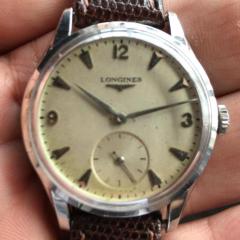How are stainless steel watch cases polished
-
Recently Browsing
- No registered users viewing this page.
-
Topics
-
Posts
-
If pivot shoulder almost touches the mainplate, you will see lower amplitude and free oscilation comes to stop quicker. Such touching can stop the watch. This caliber is based on FHF, I think. So some parts of a cheaper movement of same caliber might interchange.
-
This watch has a pin end mainspring. It's a blued steel spring and may be the original >100 year old part. As you can see, it is quite set. Can anyone suggest where I might be able to obtain such a spring today? Dimensions: Height: 140 Thickness: 010 Arbor diameter: 340 Barrel diameter 989 (1/100 mm)
-
Many thanks for your answers: 1. I will clean both of them without risk 🙂 2. Both of the rotate inside their setting but they don't seem to come out. I will clean the cock (and the hole jewels) and I will see if they want to go out. I don't intend to force the setting pushing it out by any means. I only hope I don't need the dismantle the whole cock into all its components...! 3. I won't touch it. Only clean. I don't want to take risk... Thanks again! Thanks for your anwer. Yes, I meant short. In fact there are 2 pictures where It can be seen that the balance almost touch the main plate. The balance only spin freely when I loosen the cock screw and also the bottom jewel setting. I cleaned the exterior jewels on the cock and on the main plate. But I can't take the interior settings. I uploaded 1 picture on this My reply to your comments are below. Apologies as I Replied rather than quote...
-
By worn pivot, Do you mean short ? A pivot is not short if balance spins freely on it. Dial up & dial down tests are good test for investigation, visual test alone doesn't suffice. A thorough test is free oscilation, which is best done when balance cock is adjusted with acceptable end shake. Balance settings on both side should be dismantled as they must be cleaned, pegged and inspected. Stud & pivot & where spring leaves the collet are on one line, show entire coil and where you think is bent, please. Regs
-
1. I think the pivots look pretty good and I wouldn't worry about wear. 2. Yes, I think the hole jewels should come out for cleaning, complete with their spring setting. I don't have experience with Rolex but I've seen this spring type setting in another movement. They may be stuck in with old dried oil. 3. Yes, I think the overcoil is out of shape.
-







Recommended Posts